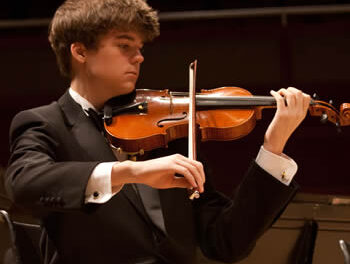The Borromeo String Quartet got out of blizzard-bound Boston to make their January 24 concert in Pinehurst’s Owens Auditorium by driving to Hartford, Connecticut, to find an open airport. Their alert and engaging performances for the Classical Concert Series belied their chaotic day.
Many big name ensembles rush through classical composers, playing them with showy technique but skimming over the deeper meanings and instrumental relationships that are naturally revealed when melodic lines are given “breathing room.” Listening to the Borromeo’s playing of Haydn’s Quartet in E-flat, Op. 64/6, was like eavesdropping on an intimate conversation among four friends. Despite exploiting quieter dynamics, all four parts were clear and in perfect balance. Intonation was closely matched, as was the phrasing, and the interpretation was a model of classical style. Haydn’s humor was fully brought out in the fast concluding movement without any heavy highlighting.
Ever time I hear a new work (or a repeat of an earlier one) by Argentinean composer Osvaldo Golijov, I become more convinced that he is one of the finest contemporary composers. His musical vernacular draws upon his Jewish heritage (klezmer), his Argentinean heritage (tango), and an eclectic palette of “World Music,” and it has an immediate resonance with audiences, much like Bach, Beethoven and Dvorák’s works do.
CVNC reviewed the world premiere of Golijov’s Tenebrae at the 2002 Spoleto Festival USA; it was commissioned by Charles Wadsworth and was originally scored for soprano, clarinet, and string quartet. The Borromeo played the composer’s arrangement for string quartet, which ought to give it wider exposure. Golijov was inspired by the juxtaposition of a new wave of violence that had begun in Israel and the view of the Earth as a beautiful blue dot in space that he had seen in a planetarium in September 2000. Haunting melodies from Couperin’s Troisieme Leçon de Tenebrae along with melismatic treatment of the Hebrew alphabet are melded into the meditative score. The soprano and clarinet parts have been subsumed into the standard quartet, mostly into the first violin and cello parts, although I thought I detected a bit of the clarinet line in the viola part. The austere low notes of the cello and the viola in opening and closing suggest the sound-world of a viol consort. A slow chant-like cello line is set against a faster but delicate repeated pattern of the viola that fleetingly suggests Phillip Glass. In brief comments, Nicholas Kitchen drew attention to “the most cosmic part” of the piece in which the three higher string parts are marked in the score, “Like tropical frogs.” A heartfelt cello melody hovers above the quivering strings. It is hard to imagine a more committed performance than that given by the Borromeo Quartet.
Music addicts and critics can hardly get through a concert season without several performances of Schubert’s beloved Quartet No. 14, in d minor, D.810 (“Death and the Maiden”). In a jaundiced mood at the prospect of hearing it yet again on the 1991 Spoleto Festival U.S.A, I had my resentment blow away by a riveting performance by the Borromeo Quartet in their first appearance at the festival. The years since may have slightly softened the edges but there was no trace of the routine in the ensemble’s Pinehurst performance. The melodies were allowed to unfold naturally, the bold opening was not overwrought, and the famous variation movement was particularly engaging. The warm and deeply involving reading brought the audience to its feet. CD sales were brisk, and many will probably consider ordering the concert on the ensemble’s “Living Archive” series.











